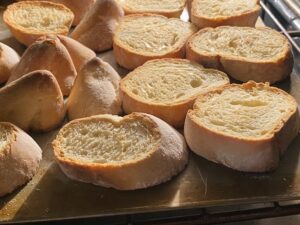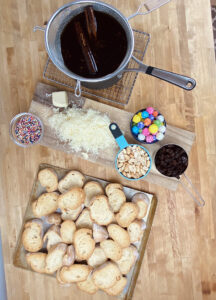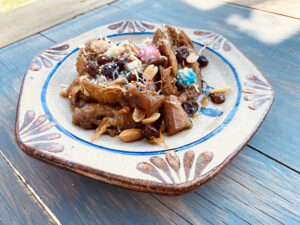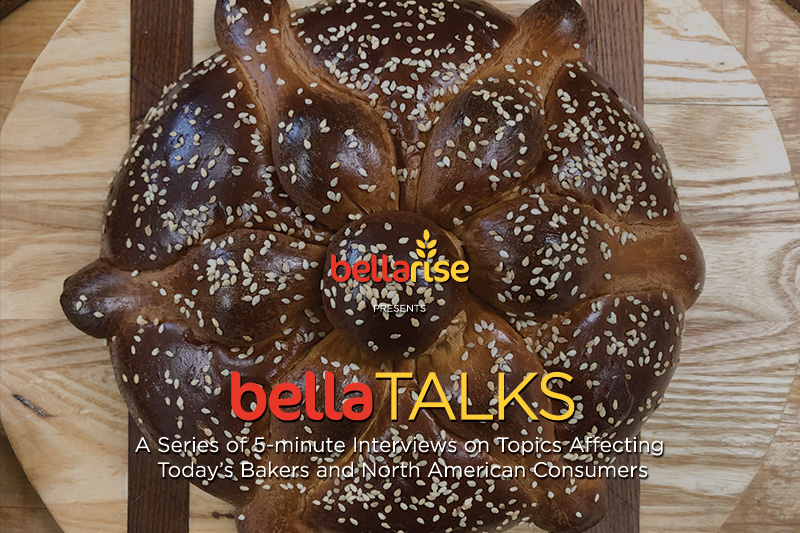PASADENA, CA – 9 April 2023 – “Capirotada!” It’s as fun a word to say as it is, indeed, food fit for a king.
As a traditional Hispanic dessert dipped in hundreds of years of Christian history, capirotada is a baked delicacy that brings culture, religion, family, and neighbors together in honor of Jesus Christ during the Lenten season. When seen from far above, the act of breaking bread is one of physical and spiritual nourishment… of joy… of friendship… and love. Up close, for many fans of Hispanic desserts it is the baking, serving, and eating of capirotada which represents a profound show of respect for Christian tradition and for all who are invited to enjoy biting into one of the most important––and delicious––dishes in all of Mexican cuisine.
Today, Chef Alex Peña, who is Director of Product Development and Technical Services at Bellarise®, introduces us to capirotada and walks us through its origin story; its cultural significance; how to bake it; and the sweet role (pun intended) it played in his relationship with his mother, Rosalia Romero Peña. For those following our narrative of Hispanic pan dulce, we find that the bolillos used in capirotada are part of the masas fermentadas (or, fermented doughs) category.
According to Peña, capirotada was enjoyed in Spain long before it reached Mexican shores during the Spanish Conquest. Its name is derived from capirote, which is a tall and conical medieval hat worn by participants in long processions observing Easter. “Capirotada itself was originally a savory dish made by emptying out the pantry of foods you couldn’t eat during Lent, and it was enjoyed on Ash Wednesday,” explains Peña. He adds that along with other cultural artifacts, capirotada crossed the Atlantic aboard Spanish galleons and arrived in Mexico sometime during the 16th and 17th centuries. In Mexico, Peña adds, capirotada became a sweet dish; in regions like Guerrero, though, it is a more savory bread pudding made with onions, tomatoes, and other such ingredients. It does have a syrup made from piloncillo, which is an unrefined brown sugar usually presented in the shape of a cone.
One way to make capirotada is to base it on bolillos, or French rolls, and cut them into medallions. “After toasting them at a low temperature, almost like a crouton… in that drying process you melt butter over them and it would seep into the medallions. The butter bakes out, and then you dust them with cinnamon and allow them to dry out some more,” says Peña. “We boil water in a stock pot, then add piloncillo, cloves, and cinnamon sticks, then reduce it to a syrup. Add toasted peanuts, raisins, colorful sprinkles that are flavored with anis, and cheese, which could be Monterey Jack––which is what my mom had available here in the U.S, or queso de chihuahua when she lived in Mexico––but different regions use other types, or even coconut and condensed milk.” After soaking that layer of ingredients in the syrup, you continue adding layers of medallions into your casserole and cover it, then place it in the oven. Once it’s out, the medallions are scooped out and served.
Each ingredient in this version of the capirotada is highly symbolic. According to Peña, “The bread itself is the body of Christ; the syrup is the blood of Christ; the cinnamon sticks represent the wood from the cross; the cloves represent the nails used to crucify Him; the white cheese represents the holy shroud used to cover Him when he was placed in the tomb; the colorful sprinkles represent life… the resurrection… Easter.” This is a Mexican interpretation, and it is more of a dessert than a savory dish, as it originally was in Spain, long ago.
“This is a very exciting topic for me, because as a child this is actually the first recipe I memorized, that my mom taught me,” reflected Peña. His family owned a bakery in Los Angeles called La Morenita, which is where he got his start producing bread for others. It was at home, though, that Peña first learned about the nuances of baking and how each region in Mexico has its own way of baking traditional Hispanic breads. Capirotada is one such Lenten dessert, as it exists in about as many different formats as there are regions in Mexico. “We would make it at home when I was a child… and the style she used was from Northern Mexico. That recipe came full circle for me, because 15 to 20 years later, I was reproducing that recipe for industrial bakeries. Fast-forward to today, and while continuing my work for industrial bakeries, I am also teaching home bakers how to bake desserts like capirotada.” Recently, a historical society of culinary artists based in Southern California invited Peña to give a presentation on capirotada on 9 April 2023; that is also his late mother’s birthday. The craft that brought his family together also gave rise to Peña’s career and lifelong love for baking.
Rosalia Romero Peña’s influence in his life continues, “and capirotada… to me it means my foundation, and my connection to my mom, who is no longer with us. I guess, I can look at the colorful sprinkles and think about her.”
(We would be remiss if we didn’t include one of Chef Alex’s recipes. Here is the one his mom taught him: the very same recipe that ignited his passion for baking. Enjoy!)










